Simply Economics October 1, 1999
By Evelina M. Tainer
Chief Economist, Econoday
Robust economic news: a concern to financial market players
Trading Sessions were mostly negative
As the quarter came to a close, stock markets were down dramatically from the year's highs. Indeed, given that a correction is technically viewed as a 10 percent drop, most of the indices have exhibited corrections. The chart below reveals that only the NASDAQ composite has posted increases in the three quarters of this year. The DJIA and the S&P 500 managed to post gains in two of the three quarters. Only the Russell 2000 gained sharply in the second quarter of this year, but fell in the first and third quarters. It is barely above yearend levels.
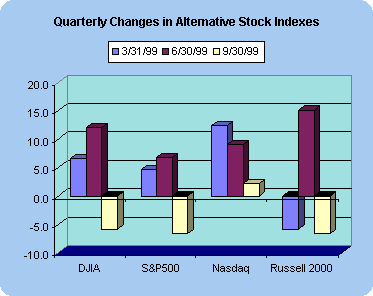
Investors tend to fear October since two major market crashes (1929 and 1987) took place during the month. In reality, September tends to be the month in which the market is more likely to decline than to increase - at least in the past 25 years. There is no question that next week's FOMC meeting will play a big role in determining in which direction the stock market will be headed for this month.
Treasury market worried about Fed rate hike
Strong economic data this week pushed down bond prices and pushed up bond yields. Notice the jump in interest rates this past week after a fairly stable period for most of August and September. Bond investors are worried that the Fed will raise rates at the FOMC meeting next week - or at the least, change from a neutral to a tightening bias. A tightening bias would indicate their belief that economic conditions might soon warrant higher interest rates. It is worth noting, however, that the Fed has not always followed a tightening bias with a rate hike.
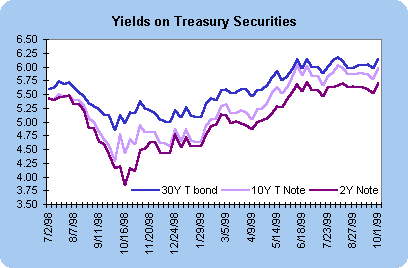
|
Markets at a Glance |
| Treasury Securities | 12/31/98 | September 24 | October 1 | Weekly
Change |
|
30 year Bond | 5.09% | 5.97% | 6.13% | + 16 BP |
|
10 year Note | 4.65% | 5.77% | 5.98% | + 21 BP |
|
5 year Note | 4.53% | 5.66% | 5.86% | + 20 BP |
|
2 year Note | 4.53% | 5.52% | 5.70% | + 18 BP |
| Stock Prices |
|
Dow Jones Industrial Average | 9181* | 10279* | 10273* | - 0.1 % |
|
S&P 500 | 1229* | 1277* | 1283* | +0.5 % |
|
NASDAQ Composite | 2193* | 2740* | 2734* | - 0.2 % |
|
Russell 2000 | 422* | 417* | 424* | +1.7 % |
| Exchange Rates |
|
Euro/$ | 1.1668 | 1.0445 | 1.0723 | + 2.7 % |
|
Yen/$ | 113.20 | 107.20 | 105.08 | - 2.0 % |
| Commodity Prices |
|
Crude Oil ($/barrel) | $12.05 | $24.76 | $24.54 | - 0.9 % |
|
Gold | $289.20 | $269.80 | $305.30 | +13.2% |
| (* rounded) - (BP = basis points; stock price indices are rounded) |
|
Commodity prices - recent changes need perspective
As you can see from the table above, the price of a barrel of crude oil is double what it was at the end of last year. These higher prices have already been reflected at the gas pump - and the various inflation measures such as the consumer and producer price indices.
More recently, market participants have experienced a run-up in the price of gold. The spurt was more dramatic this past week when European central banks announced that they would limit annual sales. The gold price spurt caused worries among financial market players and hurt both the bond and equity markets. Gold has long been an inflation hedge. Yet, if we take a look at the price of gold over a longer period of time than just the past couple of weeks, we'll see a dramatic downward trend in gold prices in the 1990s. The little uptick at the edge of the chart represents the September 30 level for gold. It barely brings us back to early 1997 when gold prices were hovering around $300/ounce. Incidentally, the gold price in the "markets at a glance" table is not a typo. Prices did jump that much in one week!
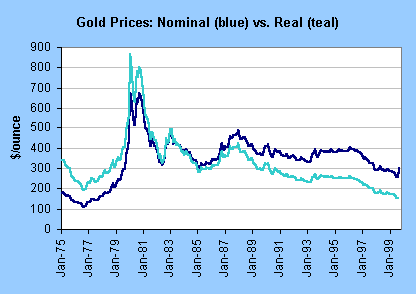
Manufacturing picks up steam
Several manufacturing indicators were reported this week - and they generally pointed to a pick up in activity. The NAPM index for September increased nearly four points to 57.8. Technically this index stands at its highest level since November 1994 (although the index was 57.7, just one tick lower in mid-1997). Manufacturing activity was sluggish in 1998 and early 1999 as producers purchased less expensive imported goods. The industry is now more lively, which should benefit companies (and stocks) of basic industries in the U.S. The major worry, though, is that price increases will translate to consumers. Note the spurt in the prices paid component of the NAPM. It is at its highest level since 1995. A good portion of this gain could be attributable to energy prices, but policymakers and financial market players fear that other raw materials prices are also accelerating.
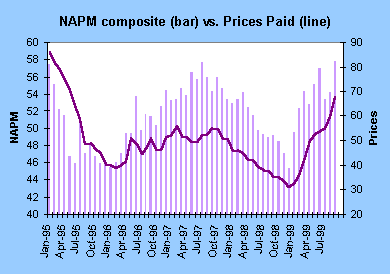
In contrast to expectations, new orders for manufacturers durable goods rose 0.9 percent in August. The bulk of the new orders were in transportation, which tend to fluctuate more dramatically than the other components. We depict year-over-year changes in total orders and nondefense capital goods orders in the chart below. While nondefense capital goods orders have not accelerated in recent months, there is a distinct upward trend in the total.
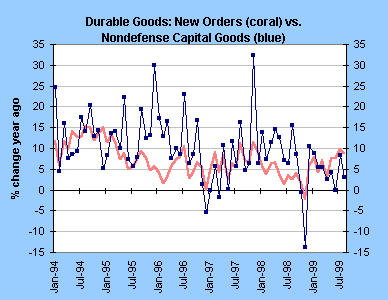
The bottom-line on manufacturing activity? Both the NAPM and durable goods reports suggest improvement in the manufacturing sector, which had not benefited from the booming economy of the past couple of years. These indicators could cause Fed officials to worry about robust demand. However, it is worth remembering that manufacturing employment has dropped off significantly in the past year, so that tight labor markets may not be a problem in this industry.
Shifting away from construction
Construction expenditures decreased in August for the fifth straight month. Despite a healthy level of housing starts, the trend is still down from early 1999. As a result, this is beginning to translate into monthly declines on investment spending in dollar terms. Nonresidential investment spending peaked earlier and has declined more dramatically in the past seven months. The chart below depicts year-over-year changes, which reveals that even with the downdraft, the residential sector is outperforming the nonresidential sector.
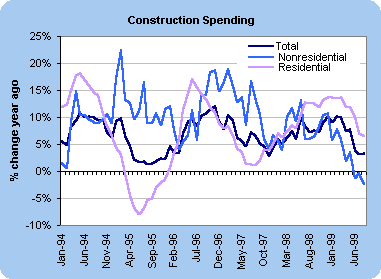
The bottom-line on construction? Shortages of labor and supplies may have forestalled growth in this sector. Yet, as the economy turns towards manufacturing and away from construction, it could lead to a more balanced environment. Federal Reserve officials will likely be relieved with the moderation in construction spending.
The U.S. Consumer - optimistic and eager to spend
Personal income rose 0.5 percent in August with a strong gain in wages and salaries. At the same time, personal consumption expenditures jumped 0.9 percent with a spurt in durable goods consumption (motor vehicle sales). Note the wide gap in the yearly percent change in income versus consumption growth. The gap was beginning to narrow a few months ago, but widened again in August. The personal savings rate ventures further and further into negative territory. The Commerce Department has indicated that the comprehensive annual revision (in November) will reveal that the savings rate is not negative. Yet, there is no question that consumers are spending more than they are earning every month.
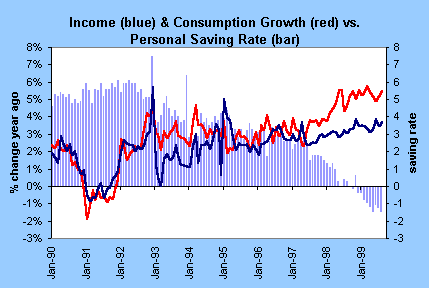
New home sales jumped 2.9 percent in August, not quite reaching a new high for this series. The gain had been unexpected since existing home sales reported last Friday had decreased by a similar amount. Since existing home sales are a larger portion of the total, single family home sales did end up modestly lower in August from the previous month. Note the sharp rise in the mortgage rate over the past six months. Weekly mortgage rates have shown a modest decline in the past few weeks from the peak level of 8.15 percent posted in mid-August. In any case, most economists are expected housing activity to moderate in coming months. Indeed, the strength of the housing market has astonished analysts who were looking for a slower pace throughout most of 1999.
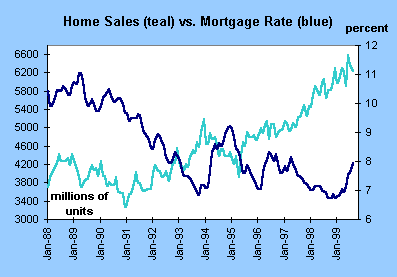
As long as housing activity continues unabated, it will spur expenditures on household furnishings and appliances. Yet, if housing activity does moderate as expected, then consumer durable spending may be curtailed in the future.
The bottom-line on the consumer sector? A low unemployment rate coupled with relatively stable prices (outside of the energy sector) have helped keep consumers rather content with their lot. Consumer confidence remains at high levels. Expenditures are robust and the housing market remains healthy. Most economists are looking for more moderate behavior in coming months - which would reduce the Fed's anxiety level about the strength of economic activity.
THE BOTTOM LINE
The Federal Open Market Committee (FOMC) is meeting on October 5 to decide the fate of monetary policy. Until this past week, market players and economists were not expecting the Fed to tighten credit conditions (that is, to raise interest rates) at this meeting. Nonetheless, the economic news was almost uniformly robust. Fed officials have claimed that they monitor the rate of economic growth as well as trends in prices. Aside from energy prices, the major inflation indicators (CPI, PPI, and GDP deflator) have not shown marked acceleration. Yet, commodity prices have posted gains in the past couple of months.
While the Fed's foremost goal is to prevent accelerating inflation, they have to be concerned about global economic and financial conditions. The sharp drop in the stock prices in the month of September have to be a consideration, even though they probably thought the market was overvalued previously.
Financial market players are likely to remain skittish in the next couple of trading sessions until the Fed makes an announcement at the end of their meeting next Tuesday. Even if the Fed doesn't change the federal funds rate target, market players will focus on the content of the announcement - and whether the Fed changed their bias from a neutral one to tightening one.
Looking Ahead: Week of October 4 to 8
We use the Market News Service survey of forecasts to describe the market consensus.
Tuesday
Economists are predicting that the Conference Board's leading indicators index will edge down 0.1 percent in August after posting modest gains in the past several months.
Wednesday
Financial market players are looking for factory orders to increase 0.7 percent in August after a 2.1 percent hike in July. This incorporates the 0.9 percent jump in durable goods reported last week in addition to a moderate gain in nondurable goods.
Thursday
Market participants are expecting new jobless claims to remain roughly unchanged in the week ended October 2 from last week's 299,000. The data could still be skewed by the aftermath of Hurricane Floyd.
Economists are predicting that consumer installment credit will rise $7 billion in August after a whopping $8.8 billion gain in July. Motor vehicle sales were robust during the month and could contribute to the overall level of installment credit.
Friday
Nonfarm payrolls are expected to increase 220,000 in September, nearly twice the pace posted in August. This reflects trend growth for this series. The civilian unemployment rate should remain unchanged at 4.2 percent. Market players are looking for average hourly earnings to rise 0.3 percent, in line with the average of the past several months. The average workweek is predicted to edge down to 34.4 in September from 34.6 in August. Hurricane Floyd devastated the coast in mid-September, about the time of the employment survey. It is possible that the figures will be affected by the hurricane.
|









